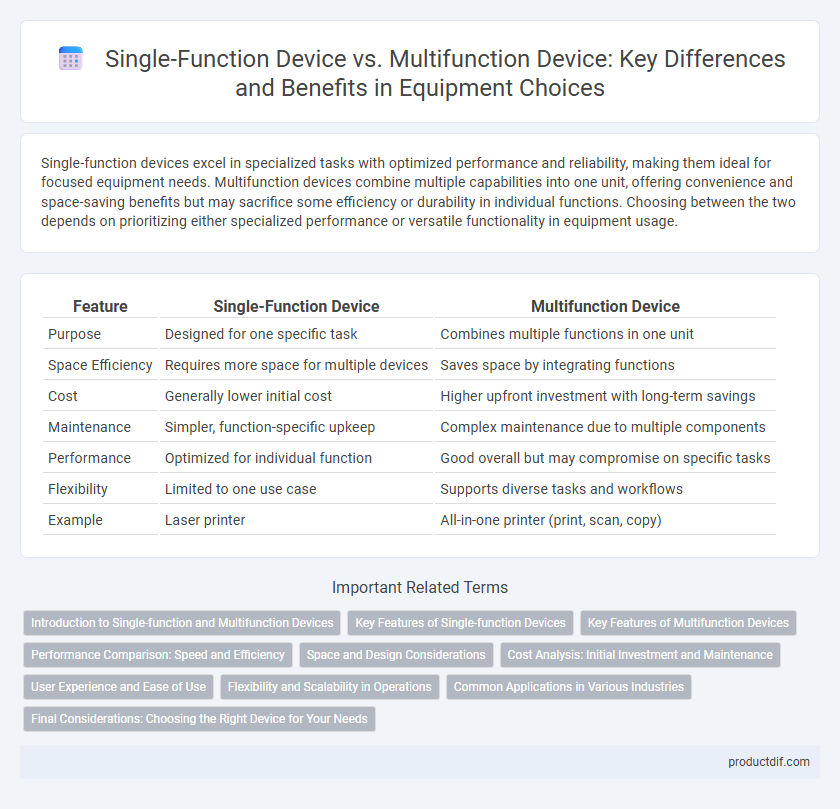Single-function devices excel in specialized tasks with optimized performance and reliability, making them ideal for focused equipment needs. Multifunction devices combine multiple capabilities into one unit, offering convenience and space-saving benefits but may sacrifice some efficiency or durability in individual functions. Choosing between the two depends on prioritizing either specialized performance or versatile functionality in equipment usage.
Table of Comparison
| Feature | Single-Function Device | Multifunction Device |
|---|---|---|
| Purpose | Designed for one specific task | Combines multiple functions in one unit |
| Space Efficiency | Requires more space for multiple devices | Saves space by integrating functions |
| Cost | Generally lower initial cost | Higher upfront investment with long-term savings |
| Maintenance | Simpler, function-specific upkeep | Complex maintenance due to multiple components |
| Performance | Optimized for individual function | Good overall but may compromise on specific tasks |
| Flexibility | Limited to one use case | Supports diverse tasks and workflows |
| Example | Laser printer | All-in-one printer (print, scan, copy) |
Introduction to Single-function and Multifunction Devices
Single-function devices are specialized equipment designed to perform a single task with high efficiency and precision, commonly found in settings requiring dedicated functions like printing or scanning. Multifunction devices integrate multiple capabilities, such as printing, scanning, copying, and faxing, into one unit, optimizing space and cost efficiency for offices. Selecting between single-function and multifunction devices depends on the specific operational needs, volume of tasks, and available workspace.
Key Features of Single-function Devices
Single-function devices excel in delivering specialized performance by focusing exclusively on one task, such as printing or scanning, ensuring higher efficiency and quality in that specific function. These devices generally offer faster operation speeds, enhanced durability, and reduced maintenance costs compared to multifunction devices due to their simplified design. Their streamlined interface and optimized hardware contribute to consistent output and reliability in professional or high-volume settings.
Key Features of Multifunction Devices
Multifunction devices integrate printing, scanning, copying, and sometimes faxing capabilities into a single unit, optimizing office space and reducing equipment costs. These devices often feature wireless connectivity, touchscreen interfaces, and advanced security options such as user authentication and encrypted data transmission. High-resolution output and automatic duplex printing are standard, enhancing productivity and enabling efficient document management in professional settings.
Performance Comparison: Speed and Efficiency
Single-function devices often outperform multifunction devices in speed due to specialized hardware optimized for specific tasks, resulting in faster processing times and higher throughput. Multifunction devices balance multiple capabilities, which can introduce latency and reduce overall efficiency when switching between functions or handling simultaneous tasks. For environments demanding high-speed output and streamlined workflows, dedicated single-function equipment typically offers superior performance and reliability.
Space and Design Considerations
Single-function devices occupy less space due to their streamlined design, making them ideal for environments with limited room. Multifunction devices, while larger, consolidate multiple functions such as printing, scanning, and copying, reducing the need for separate equipment and optimizing overall workspace efficiency. Careful consideration of available space and workflow demands is essential when choosing between single-function and multifunction devices to ensure an ergonomic and clutter-free design.
Cost Analysis: Initial Investment and Maintenance
Single-function devices typically demand lower initial investment but often result in higher cumulative maintenance costs due to needing multiple units for different tasks. Multifunction devices consolidate operations, reducing overall maintenance expenses and space requirements, which enhances cost efficiency despite a higher upfront price. Analyzing total cost of ownership reveals multifunction devices offer long-term savings by minimizing equipment redundancy and simplifying service contracts.
User Experience and Ease of Use
Single-function devices offer a streamlined user experience with intuitive controls tailored to one specific task, reducing complexity and learning curves. Multifunction devices integrate multiple capabilities, providing convenience and space savings but often require navigating more complex interfaces that can hinder ease of use. User preference depends on balancing specialized efficiency against the versatility and compactness of combined functions.
Flexibility and Scalability in Operations
Single-function devices provide consistent performance for specific tasks, ensuring streamlined operations but limited adaptability to changing workflows. Multifunction devices enhance operational flexibility by integrating multiple functions like printing, scanning, and copying into one unit, allowing businesses to scale capabilities without additional equipment. Scalability in multifunction devices supports evolving business needs, reducing downtime and optimizing space, making them ideal for dynamic work environments.
Common Applications in Various Industries
Single-function devices excel in specialized tasks such as industrial 3D printing for aerospace components, while multifunction devices offer versatility in office environments by integrating printing, scanning, and faxing functions. In manufacturing, single-function machines like CNC routers deliver precision, whereas multifunction devices support administrative workflows with combined capabilities. Healthcare settings benefit from multifunction devices that streamline patient data management alongside imaging, contrasting with single-function devices designed solely for diagnostic purposes.
Final Considerations: Choosing the Right Device for Your Needs
Selecting the right equipment depends on specific operational requirements and budget constraints, with single-function devices offering streamlined performance and lower initial costs, ideal for specialized tasks. Multifunction devices integrate printing, scanning, copying, and faxing capabilities, maximizing office space and improving workflow efficiency for diverse needs. Evaluating long-term maintenance expenses, compatibility with existing systems, and scalability is essential to ensure the chosen device supports productivity and cost-effectiveness.
Single-function device vs multifunction device Infographic

 productdif.com
productdif.com